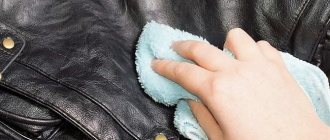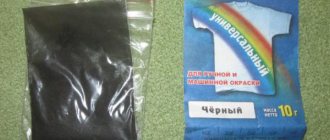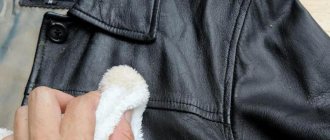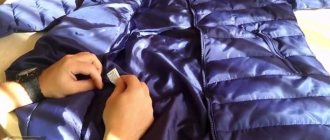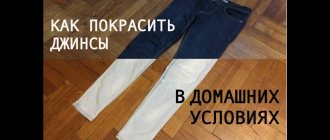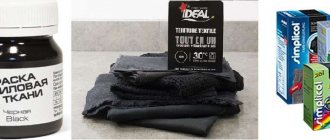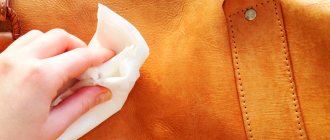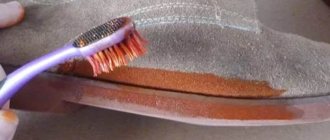Felix I've been wearing this jacket for over 5 years
The jacket is made of genuine leather, wear-resistant and durable. I've been wearing my leather jacket for more than 5 years. But about once every 2 years you have to bring it into divine shape - creases, cracks, and abrasions appear on the skin. They give clothes an unkempt look. I will share my experience on how to dye a leather jacket at home.
Repaint clothes in a color similar to the original, otherwise the paint will apply unevenly and stains will appear.
Types of paints
Paints vary in composition, release form and color range.
Aerosol
When sprayed, the dye is applied evenly. Painting is done in 2-3 layers. Depending on the composition of the aerosol, each layer dries from 1 to 6 hours.
Advantages:
- high absorbency;
- large assortment of shades;
- convenient use;
- no need to buy painting tools (brushes, sponges);
- Suitable for complete dyeing of outerwear.
The disadvantage is the need to carry out work in the open air, wearing a respirator and protective clothing, so that aerosol splashes do not get on the mucous membranes and into the respiratory tract. To protect surfaces that are not to be painted from accidental spraying of aerosol, they are covered with oilcloth.
Liquid
Best suited for dyeing leather jackets at home. The composition is applied in a thin layer and dries in 2 hours. The liquid dye is packaged in tubes with a foam tip. They renew the color of the leather jacket and eliminate minor abrasions. It is better to use for spot local painting. Disadvantages include the need to purchase a soft sponge for application and the use of protective gloves while working.
Powdery
The powder is pre-dissolved in water in the proportions specified in the instructions. The resulting solution is heated to 95 °C. When the mixture has cooled to 45°C, the leather jacket is completely immersed in it and kept for a certain time.
The advantage of powdered dyes is the uniform coloring of the fabric. But they are less stable compared to aerosols and require preliminary preparation.
Creamy
Cream paint is sold in tubes and has the consistency of a thick paste. It penetrates deeply and quickly into the material. Oil- or water-based pastes mask abrasions and scratches well; they are processed twice. The included oil makes the fabric denser and stiffer, and water softens the texture and preserves the natural qualities of the material. Among the disadvantages, users note that it is not always convenient to use, especially when the paste runs out and has to be squeezed out.
How to paint a leather jacket using liquid paint: instructions
Thanks to this paint, you can completely restore your jacket! By the way, all seams, pockets or other small and hard-to-reach parts can also be carefully painted. The choice of liquid paint is very impressive. But the main colors sold on store shelves are brown and black. All that remains is to catch the tone. But with bright shades there is a bit of a problem - you will need to order them only online.
- Some manufacturers' jars themselves come with a soft sponge. If you don’t have such a thing, then arm yourself with an ordinary kitchen sponge. And be sure to wear gloves!
Important: Give preference to oil-based paints! Or at least choose a composition close to natural ingredients. It is the oils that ensure the softness of the leather, the shine of the product and greater durability of the paint.
- A jacket usually requires 2 tubes, but it also depends on their volume. On average, a jacket needs 100-150 g of paint. Again, the degree of abrasion affects. Check the paint first on an inconspicuous area of the product! If the shade is suitable, only then start working.
- It is necessary to pour the contents of the tube into an enamel or glass container . Under no circumstances should you take aluminum containers, since oxidation is possible. And this will ruin both the bowl and the paint.
- If you choose regular liquid paint, then add a couple of drops of castor oil. This will give extra softness to the skin after drying.
- Lay out the jacket on a flat surface, having previously covered it with paper or a waterproof cloth.
Rub the paint in a circular motion and don't forget to wear gloves
- Dip a washcloth into the paint and apply it to the jacket in small portions. circular movements .
- Take your time, carefully work through every centimeter. And make sure that the paint applies evenly and the tone is the same.
- It's worth going over areas that are too worn out twice. And what’s convenient is that you can easily paint the collar and cuffs.
- Next, hang the jacket on hangers and leave it to dry. When it's dry, go over the jacket with a dry cloth made of natural fabric to smooth out any rough edges. Liquid paint will take at least 2 hours to dry.
- If there is excessive shine from the paint, then you need to rinse with water and wipe dry. Or use a topcoat. It will also remove some excess shine.
Important: It is forbidden to dry the jacket near a radiator or with a hairdryer. High temperatures will cause the paint layer to crack.
- To ensure the paint adheres better, be sure to apply a topcoat . To do this you need to mix: 2 tbsp. l. salt;
- 5 tbsp. l. vinegar;
- 1 liter of water.
Dyeing can turn an old jacket into something new.
Proven paints for leather jackets
- Saphir. An effective, economical and safe dye for humans. Available in the form of aerosols, liquids and bottles with an applicator.
- Le Tech. Product for full or partial dyeing of leather items. Easy to apply by hand or spray. Has increased wear resistance.
- Salamander. Characterized by high wear resistance, rich colors, shades that match the description.
- Sitil. Suitable for home use. Easy to apply, returns color and shine to fabric. Suitable for all skin types.
- Fiebing`s. The products are alcohol-based, quickly absorbed, and are available in 29 colors.
How to care for leather products
Although leather is a durable material, it requires care and timely maintenance. Then products made from it will retain an attractive appearance for a long time, which includes:
- impregnation with water-repellent preparations, which is carried out twice a month;
- carefully drying wet items on a hanger or in a lying position, away from heating devices;
- treatment with conditioner, which prevents drying of the skin, loss of color and maintains the fat balance in the product;
- periodic use of products to maintain or restore shine.
Leather material requires some care.
Using these simple recommendations, you can give your leather jacket a “second life” and use it for a long time.
Traditional painting methods
- Potash and soda ash can be used to dye leather brown.
- By rubbing alder bark tincture into the skin, depending on the duration of the process, you can get different shades of brown.
- The gray color is obtained using iron sulfate.
- Fucorcin tincture will give the skin a raspberry tint.
- Fukortsin mixed with brilliant green will turn the skin black and blue.
- Zelenka or basma will dye clothes green, and concentrated basma will dye them black.
- Potassium permanganate can make the skin color rich brown, iodine will give the brown a golden hue, and henna will make it a burning red.
- Stain imparts a brown tint to light-colored leather.
- Nails boiled in vinegar will turn your leather jacket black.
- Tea will give clothes a beige tint.
- Onion skins or chestnut rhizomes add a golden hue.
Coloring methods
- Surface. The paint is applied only to the outer side, the skin is painted pointwise, locally. Any type of dye is suitable. Before painting, the skin area is degreased with acetone, then 2-3 layers of paint are applied and dried.
- Deep. The surface of the leather jacket is saturated with dye: the item is completely soaked in it for the length of time recommended by the paint manufacturer. Next, the jacket is fixed on a wooden furniture board for drying. Additionally, paint fixative and fat impregnation can be used. During soaking, the jacket must be constantly turned over to achieve even coloring.
Stages of work
You should start applying the dye from the abrasions. This way it will lie more evenly. First, you need to assess the condition of the item and determine where the most abrasions are. They may be located:
- on the collar;
- on seams and external stitches;
- in the cuff area;
- on the front slats;
- on a belt or belt;
- in the upper back.
After treating areas with abrasions, the second step is to clean the entire surface of the product.
Where can I paint?
A dry cleaner or specialized salon has equipment that determines a number of important characteristics of a leather jacket:
- degree of wear;
- material;
- fabric density;
- exact shade of the original dye;
- the ability to repaint the product in a different color;
- optimal painting method;
- method of applying a protective layer;
- type of further polishing.
Before dyeing, specialists must clean the jacket and remove defects on it, but such services are quite expensive.
If your financial situation does not allow you to turn to services, you can dye your jacket at home. But at home you can only update the color; it is unlikely that it will be possible to restore its structure. The easiest way to use cream paint at home is to simply apply it and penetrate deeply into the material.
Requirements for leather paint
There is no paint specifically designed for dyeing leather products. Compositions that are applied to a smooth leather surface are intended for coloring various types of materials. Types of paints have their advantages and disadvantages. The compositions are classified according to the type of coating.
| Type | Description |
| Penetrating | Pigments penetrate into the skin structure |
| Covering | Pigments cover the surface, creating a water-repellent film |
How to prepare a jacket
The jacket must be cleaned of dust, dirt and grease stains on the sleeves and collar. Dust is wiped off with a damp cloth. Greasy traces are removed with a soap solution prepared on the basis of glycerin soap, gasoline or ammonia. Dirt is washed off with warm water and laundry soap, and dark skin is well cleaned with lemon juice diluted with water in a 1:1 ratio.
Cleaning rules:
- The skin should not be wetted too much; it should be wiped with a thoroughly wrung-out cloth;
- all folds and seams are cleaned so that no dirt goes unnoticed;
- After cleaning, the soap solution must be washed off with clean water;
- Drying the jacket after cleaning is done away from direct sunlight and sources of artificial heat. Only with natural drying will the skin not lose its shape and become rough.
After cleaning, the jacket is degreased. Use regular acetone mixed with water or alcohol. Proceed with painting only after the jacket has completely dried.
Preparation
All leather products undergo a dyeing procedure. It is a fact. Therefore, it is quite logical that over time, faded spots, bald spots, and other completely unattractive areas appear on them.
Restoring the appearance of the product is very simple. You just need to paint it. It's not difficult to make it yourself. There are ready-made products for this on the market. But first things first.
Cleansing
If you decide to do the coloring yourself at home, you should not start this process right away. It is necessary to carry out preparatory work. First you need to check the pockets, remove the lining, fur collar and other removable elements.
Then degrease the surface of the skin. If this is not done, the coloring will be uneven. And the result will be even worse than before.
Lay the jacket out on a flat surface or hang it on a trempel. Take a clean dish sponge or microfiber cloth, slightly dampen it and thoroughly wipe the entire surface of the leather product from dust and possible dirt. This is a very important stage. If particles of dirt remain on the product, it will not be possible to paint it evenly.
How to degrease
After cleaning, the jacket should be degreased before painting. Under no circumstances use acetone or other similar products that are sold in hardware and construction stores. They are overly aggressive and can corrode the skin.
The easiest way to degrease is to use available products. If the product is dark, you can wipe its surface with a solution of lemon juice and water (proportion one to one). Wetting a cotton pad in the resulting mixture, you need to carefully treat a black, dark gray or brown jacket.
The second option is a degreasing solution, a mixture of soap and glycerin. For 200 milliliters of water you need to take 20 g of fine soap shavings and three tablespoons of glycerin. Mix thoroughly, and then use a new dish sponge to wipe the leather product several times.
There is another way to degrease the surface - egg white. It needs to be whipped into a stiff foam and wiped over the product. This option is ideal if you have to dye a white or beige jacket.
Now that the jacket is completely degreased, you need to let it dry thoroughly. To do this, you need to hang it on a trempel and leave it at room temperature for several hours.
How to paint correctly
It is best to paint a leather jacket in a vertical position, placed on a hanger or a mannequin. Old towels or rags are placed under the shoulders, back and collar. Painting in a horizontal position is possible, but not always convenient.
Painting black or another shade occurs in stages.
- Use a sponge soaked in an aqueous or alcohol solution of acetone to wipe the entire jacket. This is done to remove the protective wax from the product.
- The skin is lubricated with a gelatin solution. To prepare it, 1 tablespoon. gelatin is diluted in a glass of cold water. The mixture is heated over low heat until the gelatin grains are completely dissolved. The solution is applied with a brush.
- After smearing with gelatin, you can start painting no earlier than half an hour later. This time can be spent preparing the dye.
- Initially, the most worn areas are painted, after which the entire surface is treated. The seams on the sleeves, collars and areas around the fasteners are especially carefully coated.
Optimal climatic conditions are created for painting: air temperature +16...+20 °C, air humidity - no more than 75%. It is necessary to operate in a well-lit and ventilated area.
The drying time of the paint depends on the brand and is indicated by the manufacturer in the instructions. It is impossible to artificially speed up drying using various heating devices. The skin should dry naturally.
As for the method of applying paint, it does not depend on the color, but may differ for different release forms.
Aerosol can
The leather jacket hangs on hangers. The zippers are sealed with adhesive tape, and the buttons are pre-cut. The aerosol is sprayed evenly over the entire surface of the product, while the can is held at a distance of 28-32 cm from it. After the dye is absorbed, the item is wiped with a soft material, such as velvet or velor. This is necessary to remove excess dye.
Cream paints
The dye is squeezed out of the tube onto a washcloth. The entire surface of the jacket is wiped with a sponge. You can wear the product after the paste is completely absorbed and the skin is dry.
Liquid dye
A solution of liquid product with water is prepared in a deep basin, as indicated in the instructions. The skin is immersed in a container with pigment. For uniform dyeing, it is necessary to constantly turn the clothes in the basin. After some time, the jacket is pulled out of the dye and hung on hangers to dry. To fix the color, after complete drying, the skin is wiped with a warm vinegar-salt solution.
Powder product
The powder is diluted in warm water. The resulting solution is poured into a large container, 2 liters of water are added to it. The solution is placed on fire and boils. When the boiling mixture cools to 40-45°C, the leather jacket is immersed in it. To obtain a uniform, rich color, the product is constantly turned in different directions. After a certain time, the item is removed from the dye, wrung out and rinsed in clean water.
Workplace
Restoration of the product should be carried out in a clean and well-ventilated area. Preferably in daylight. The surface on which the work will be done must be covered with polyethylene or cling film.
Hand protection gloves
Required equipment:
- coloring agent;
- cling film;
- rags or paper napkins;
- trepmel;
- respirator mask;
- medical gloves.
It is important to protect objects and surfaces of the surrounding area in the painting area. It is best to use cling film.
The jacket must be hung on the trempel, buttoned up, to protect the lining material from paint.
Expert opinion
Irina. Housewife.
Ask a Question
Protect your face with a mask, and wear thin medical gloves on your hands; they are comfortable to work in. It's better to stock up on several pairs.
Is it possible to repaint it in a different color?
At home, you can only repaint a jacket in a darker shade. It is possible to radically change the color of a product only in specialized salons. To obtain the desired shade, you need to repaint your leather jacket in accordance with the following recommendations:
- the new shade should be a maximum of 2-3 shades darker than the old one;
- The choice of color depends on the original color of the clothing. If it was in cold tones, the new shade should be from the same color range; the situation is the same with warm tones.
How to paint a jacket in the easiest way using an aerosol: tips and tricks
It is worth immediately noting that this paint is very convenient to use, a small amount of dye is consumed, and it covers the jacket with a very thin layer. Moreover, you yourself can easily control the thickness of the paint. But there is one drawback - it is only suitable for light touch-ups and requires regular updating.
- In addition to preparing the jacket for painting, you also need to choose the appropriate aerosol. Spray cans fill both store shelves and lists on Internet sites. Choose a suitable shade as the transitions may be noticeable. And keep in mind this regularity - a lighter jacket can be painted in tones slightly darker than the previous color.
- Consider the material of your jacket as well. The distribution of aerosols follows the same criteria. Sprays for suede, nubuck and smooth leather are sold separately. For a short jacket you will need at least 2 cylinders, and for an elongated item the consumption will double.
- Choose a suitable place - it should be a well-ventilated area . Ideally, carry out this procedure on the street. The cylinder often emits a pungent and unpleasant odor. And in a closed space, paint fumes can cause headaches and dizziness, as well as poisoning. It doesn't hurt to wear a respirator or disposable mask.
- And, of course, do not lose sight of the nuance that the spray can stain other objects around. Alternatively, you can use the garage, but lay out other necessary items first. Don't forget about the floor; it won't hurt to cover it with newspapers or polyethylene.
- Be sure to wear gloves! Unless you want to paint your fingers along with your jacket. By the way, sometimes such paint can cause burning and redness on the skin.
Important: If possible, seal zippers with duct tape. Otherwise, they will also become colored. But the buttons will need to be cut off. Otherwise, they will interfere with uniform coloring! If the buttons are tightly fastened, then cover them with tape and carefully outline them with an aerosol.
Spray painting should be done outdoors or in a garage.
- Hang your jacket on hangers. Moreover, make sure that no bends or folds are formed. This will negatively affect the quality of the painting. Also note that the bottom of the product should not touch the floor or other surface. Otherwise, it threatens to erase the paint from below. The minimum limit should be at least 20 cm from any surface.
- You need to keep the balloon at a distance of 20-25 cm . This will allow you to apply a thin and even layer. The closer you hold the can, the thicker the paint will adhere. And this can cause the formation of drips. Don't forget to shake the container first.
- Distribute the spray evenly over the jacket so that the end result is the same color. Don't stay in one area for too long. If there is a spot of a different color in any place, paint over it in a second circle. But the next layer can be applied no earlier than after 15 minutes.
- Particular attention should be paid to the armpits, collar and cuffs. It wouldn't hurt to paint the last two parts on the inside. To avoid damaging fabric areas, cover them with construction tape. It can be easily removed after the paint dries.
Important: Paint the jacket using the correct aerosol strictly from top to bottom! This will help to obtain a uniform color and avoid drips.
- Aerosols flow more than other paints. Therefore, after 30 minutes you need to walk a small piece of fabric (only velvet or velor is suitable) over the surface. This will remove excess paint. The jacket takes about an hour to dry. But take into account the manufacturer and the thickness of the layer.
- Although aerosols are now sold with water-repellent particles, it doesn’t hurt to apply a final layer. This will make the paint more durable. You can use store-bought fixative. But it is better to give preference to water-based preparations. Although it depends on your desire - whether you want your jacket to be matte or glossy.
- If there are any imperfections or cracks, go over such places with regular shoe polish (it is better to use colorless cream), furniture mastic or even wood wax. By the way, they also come in different colors. There is an even simpler method - use beeswax or paraffin.
Using an aerosol you get a thin layer that you can adjust yourself
Useful tips
- If you need to completely repaint a leather jacket in a different color, it is better to leave it in the hands of specialists. At home, you can restore the original shade of the product;
- Before processing the entire jacket, it is better to test the dye on an inconspicuous area, for example, the armpit;
- synthetic fibers are tinted worse than natural materials;
- It is better not to use a brush to apply the dye. It lays down in a thick layer and streaks often appear. A foundation sponge or small sponge is suitable for this task;
- paint from a jacket that gets on human skin during treatment must be immediately washed off with soap and water. Dye that gets on the mucous membrane of the eye is washed off with a large volume of water; in especially severe cases, medical attention may be needed;
- to minimize negative consequences, painting is carried out wearing nitrile gloves and a protective mask in a well-ventilated area;
- Most degreasers are highly flammable, so it is best to prepare for painting away from sources of fire and avoid smoking;
- When choosing a dye, you need to make sure that it is suitable for coloring leather. The product must be prepared and used strictly in accordance with the instructions, taking into account the manufacturer’s recommendations and warnings;
- After painting, it is advisable to treat the jacket with a fixative. This can be a self-prepared vinegar-salt solution or a purchased acrylic-based product.
Selecting the right product
To repaint a leather jacket black or another color or restore an old one, a dye is needed. There is plenty to choose from. Knowing certain nuances will help you choose a product.
Suitable for home coloring:
- Liquid paints.
- Aerosols.
- Powder dyes.
The dyeing process using any of them is completed with the use of a special fixative.
Is a dishwasher profitable?
Oh yes! No
Which colors should you prefer?
Properties of important elements:
- Wax included. It gives leather products softness and shine. Smoothes out cracks and abrasions.
- Walnut oil. Makes the surface smooth. Some manufacturers use analogues in the form of petroleum jelly and glycerin instead.
- Jojoba or olive oils. They have a positive effect on the skin, nourishing and protecting it.
- Seal fat. Has water-repellent properties.
- Mink oil. Protects and gives the product a well-groomed appearance.
A good dye does not have to be expensive. Before purchasing, you need to read reviews and study the composition of the product. Relying on consumer experience is the most reliable option.
The French company Saphir produces leather dyes; they are very popular due to their positive reputation.
Leather dyeing process
